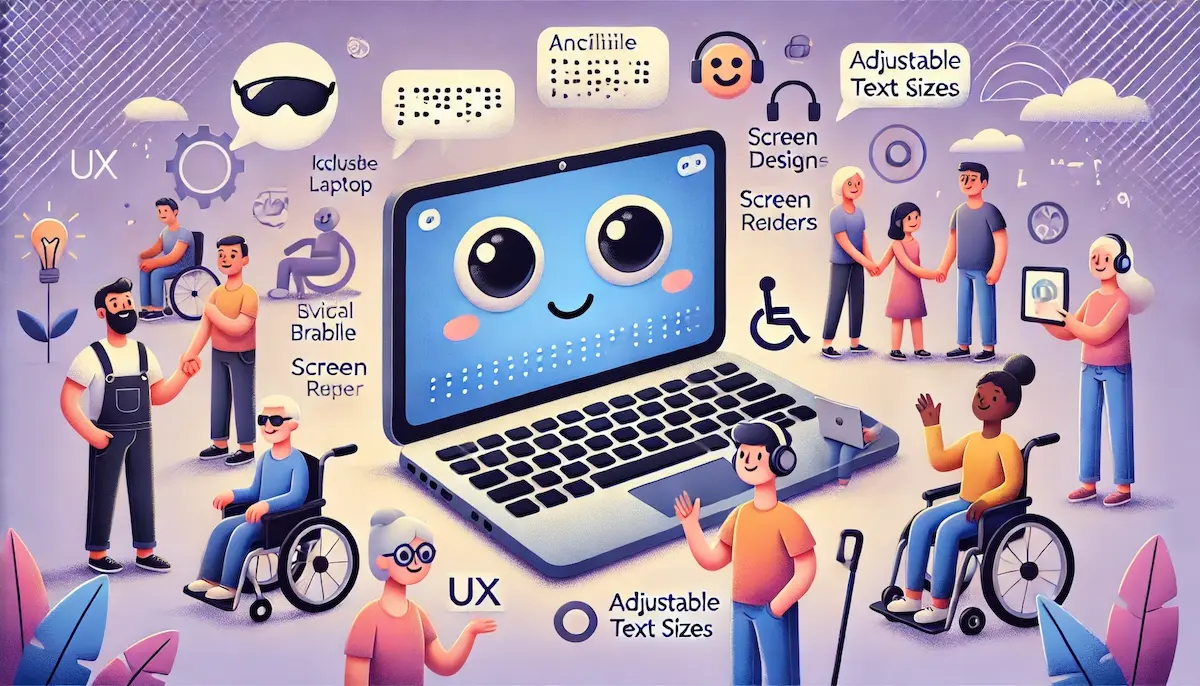Accessibility in UX (User Experience) design ensures that digital products are usable by everyone, including people with disabilities. By prioritizing accessibility, designers can create more inclusive, user-friendly experiences that cater to a wider audience. This not only improves usability for all users but also complies with legal requirements and promotes social responsibility.
What is Accessibility in UX?
Accessibility in UX refers to the practice of making websites, applications, and other digital products accessible to people with diverse abilities. This includes users with visual, auditory, motor, cognitive, and other disabilities. The goal is to remove barriers that might prevent people from interacting with or accessing digital content.
The Importance of Accessibility in UX
Accessibility is crucial for several reasons:
- Inclusivity: Designing for accessibility ensures that all users, regardless of their abilities, can access and use digital products.
- Legal Compliance: Many countries have laws and regulations that require digital products to be accessible. Non-compliance can result in legal consequences.
- Improved Usability: Accessible design often leads to better overall usability, benefiting all users, including those without disabilities.
- Wider Audience: By making products accessible, businesses can reach a broader audience, including the aging population and people with temporary disabilities.
- Social Responsibility: Prioritizing accessibility demonstrates a commitment to social responsibility and ethical design practices.
Key Principles of Accessibility in UX
Several principles guide the creation of accessible digital products:
- Perceivable: Information and user interface components must be presented in ways that users can perceive. This includes providing text alternatives for non-text content and ensuring that content is adaptable to different formats.
- Operable: Users must be able to interact with the interface. This includes making all functionality available from a keyboard, providing sufficient time for users to read and use content, and avoiding designs that could trigger seizures.
- Understandable: Information and the operation of the user interface must be understandable. This includes making text readable and understandable and ensuring that the interface behaves in predictable ways.
- Robust: Content must be robust enough to be interpreted by various user agents, including assistive technologies. This involves using web standards and ensuring compatibility with current and future technologies.
Implementing Accessibility in UX Design
Implementing accessibility involves several steps:
- Conduct User Research: Understand the needs of users with disabilities by conducting interviews, surveys, and usability testing with diverse user groups.
- Follow Accessibility Guidelines: Adhere to established guidelines such as the Web Content Accessibility Guidelines (WCAG), which provide a comprehensive set of recommendations for making web content accessible.
- Use Semantic HTML: Use proper HTML elements for their intended purposes to improve accessibility for screen readers and other assistive technologies.
- Ensure Keyboard Accessibility: Design interfaces that can be navigated and operated using a keyboard alone, as some users may not be able to use a mouse.
- Provide Text Alternatives: Offer text alternatives for non-text content, such as images, videos, and audio, to ensure that users with visual or auditory impairments can access the content.
- Design for Color Blindness: Use color schemes that are distinguishable by color-blind users, and avoid relying solely on color to convey important information.
- Test with Assistive Technologies: Regularly test digital products with various assistive technologies, such as screen readers, magnifiers, and voice recognition software, to identify and address accessibility issues.
- Continuous Improvement: Accessibility is an ongoing process. Continuously gather user feedback and conduct accessibility audits to make necessary improvements.
Tools and Resources for Accessibility
Several tools and resources can assist in creating accessible digital products:
- WAVE (Web Accessibility Evaluation Tool): An online tool for evaluating web accessibility and identifying WCAG compliance issues.
- AXE Accessibility Checker: A browser extension that helps developers test and fix accessibility issues.
- Color Contrast Analyzers: Tools like the Colour Contrast Analyser from TPGi help designers ensure sufficient contrast between text and background colors.
- Screen Readers: Software such as JAWS, NVDA, and VoiceOver that simulate the experience of users who rely on screen readers.
- WCAG Guidelines: The Web Content Accessibility Guidelines provide comprehensive recommendations for making web content accessible.
Conclusion
Accessibility in UX design is essential for creating inclusive, user-friendly digital products that cater to a diverse audience. By following key principles and implementing best practices, designers can ensure their products are accessible to everyone, enhancing usability and promoting social responsibility.
Blockfine thanks you for reading and hopes you found this article helpful.
